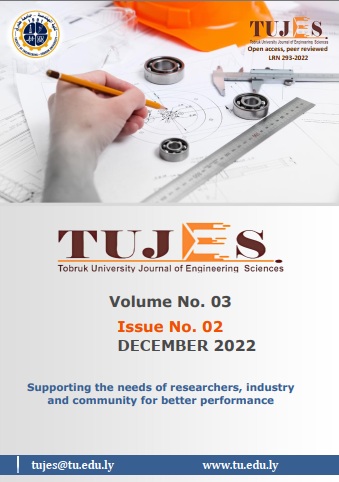Assessment of soil compaction properties: A review
DOI:
https://doi.org/10.64516/tgj9w478Keywords:
Compaction characteristics, prediction, soil compaction, unit weight, moisture contentAbstract
Laboratory determination of the compaction properties of soils is important for use in geotechnical structures. Since compaction properties are normally determined by conducting either standard proctor or modified proctor tests that are laborious and time-consuming, it is useful to review the existing literature where maximum unit weight and optimum moisture content values could be reliably correlated with the indices of soil. This paper reviews literature relating to the soil properties that control the compaction characteristics and introduces some efforts to predict the compaction properties of soils using the index test results. This review was assembled from the existing literature to make an available convenient introduction to this subject, which is of interest to engineers in many diverse fields of civil engineering. From the results of many previous studies, it was proven that, with different and acceptable degrees of confidence levels these properties were proven to be successfully used in estimating of the compaction parameters.
References
1. Kodikara, J., T. Islam, and A. Sounthararajah, Review of soil compaction: History and recent developments. Transportation Geotechnics, 2018. 17: p. 24-34.
2. Pillai, G.A. and P.P. Vinod, Re-examination of compaction parameters of fine-grained soils. Proceedings of the Institution of Civil Engineers-Ground Improvement, 2016. 169(3): p. 157-166.
3. Ebels, L., R. Lorio, and C. Van der Merwe, The importance of compaction from an historical perspective. SATC 2004, 2004.
4. Das, B.M., Principles of geotechnical engineering. Fifth Edition ed. 2002: Cengage learning.
5. Proctor, R., Fundamental principles of soil compaction. Engineering news-record, 1933. 111(13).
6. Horn, H.M. AN INVESTIGATION OF THE FRICTIONAL CHARACTERISTICS OF MINERALS. 1961.
7. Hogentogler, C. Essentials of soil compaction. in Highway Research Board Proceedings. 1937.
8. Foster, W.R., J. Savins, and J. Waite, Lattice expansion and rheological behavior relationships in watermontmorillonite systems. Clays and Clay Minerals, 1954. 3(1): p. 296-316.
9. Tripathy, S., K.S. Rao, and D. Fredlund, Water content-void ratio swell-shrink paths of compacted expansive soils. Canadian geotechnical journal, 2002. 39(4): p. 938-959.
10. Islam, S., Permeability characteristics of lime treaded soils. 2001.
11. Ranjan, G. and A. Rao, Basic and applied soil mechanics. 2007: New Age International.TUJES. Open Access. LRN 293-2022 Available at www.tu.edu.ly 8
12. Doumi, K., et al. Influence of gradation parameters on compaction of sand-silt mixtures: a laboratory assessment. in International Symposium on Construction Management and Civil Engineering (ISCMCE-2017) Skikda-Algeria. 2017.
13. Casagrande, A., Classification and identification of soils. Transactions of the American Society of Civil Engineers, 1948. 113(1): p. 901-930.
14. Malizia, J.P. and A. Shakoor, Effect of water content and density on strength and deformation behavior of clay soils. Engineering Geology, 2018. 244: p. 125-131.
15. Arvelo, A., Effects Of The Soil Properties On The Maximum Dry Density Obtained Fro. 2004.
16. Attom, M.F., The effect of compactive energy level on some soil properties. Applied Clay Science, 1997. 12(1- 2): p. 61-72.
17. Holtz, R.D., W.D. Kovacs, and T.C. Sheahan, An introduction to geotechnical engineering. Vol. 733. 1981: Prentice-Hall Englewood Cliffs.
18. Garg, A. and C.W.W. Ng, Investigation of soil density effect on suction induced due to root water uptake by Schefflera heptaphylla. Journal of Plant Nutrition and Soil Science, 2015. 178(4): p. 586-591.
19. Tang, C.-S., et al., Tensile strength of compacted clayey soil. Journal of Geotechnical and Geoenvironmental Engineering, 2015. 141(4): p. 04014122.
20. Sadek, M.A., Y. Chen, and J. Liu, Simulating shear behavior of a sandy soil under different soil conditions. Journal of Terramechanics, 2011. 48(6): p. 451-458.
21. Fatahi, B., H. Khabbaz, and B. Fatahi, Improving Geotechnical Properties of Closed Landfills for Redevelopment Using Chemical Stabilization Techniques: A Case Study on Samples of a Landfill Site in Southwest of Sydney, in Ground Improvement Case Histories. 2015, Elsevier. p. 239-266.
22. Rohit, G., Effect of soil moisture in the analysis of undrained shear strength of compacted clayey soil. Journal of Civil Engineering and Construction Technology, 2013. 4(1): p. 23-31.
23. Hamidi, A., M. Alizadeh, and S. Soleimani, Effect of particle crushing on shear strength and dilation characteristics of sand-gravel mixtures. International Journal of Civil Engineering, 2009. 7(1): p. 61-71.
24. Dadkhah, R., et al., The effect of Scale Direct Shear Tests on The Strength parameters of Clayey Sand in Isfahan city, Iran. Journal of Applied Sciences, 2010. 18.
25. Chenari, R., Tizpa, P., Ghorbani, M., Machado, S. and Karimpour, M., The use of index parameters to predict soil geotechnical properties. Arabian Journal of Geosciences, 2015. 8(7): p. 4907-4919.
26. Farooq, K., J.D. Rogers, and M.F. Ahmed, Effect of Densification on the shear strength of landslide material: A Case Study from Salt Range, Pakistan. Earth Science Research, 2015. 4(1): p. 113.
27. Tabibnejad, A., et al., Effect of gradation curve and dry density on collapse deformation behavior of a rockfill material. KSCE Journal of Civil Engineering, 2015. 19(3): p. 631-640.
28. Alshameri, B., A. Madun, and I. Bakar, Comparison of the effect of fine content and density towards the shear strength parameters. Geotechnical Engineering, 2017. 48(2): p. 104-110.
29. Cho, G.-C., J. Dodds, and J.C. Santamarina, Particle shape effects on packing density, stiffness, and strength: natural and crushed sands. Journal of geotechnical and geoenvironmental engineering, 2006. 132(5): p. 591- 602.
30. Huang, C., et al., Factors affecting the swelling-compression characteristics of clays in yichang, China. Advances in Civil Engineering, 2019. 2019.
31. Sridharan, A. and Y. Gurtug, Swelling behaviour of compacted fine-grained soils. Engineering geology, 2004. 72(1-2): p. 9-18.
32. Hussain, S., Effect of compaction energy on engineering properties of expansive soil. Civil Engineering Journal, 2017. 3(8): p. 610-616.
33. Daniel, D.E., Geotechnical practice for waste disposal. 2012: Springer Science & Business Media.
34. Ahmad, K., Y. Yamusa, and M.B. Kamisan, Effects of soil recompaction on permeability. Science World Journal, 2018. 13(3): p. 6-9.
35. Amadi, A.A. and A.O. Eberemu, Delineation of compaction criteria for acceptable hydraulic conductivity of lateritic soil-bentonite mixtures designed as landfill liners. Environmental Earth Sciences, 2012. 67(4): p. 999- 1006.TUJES. Open Access. LRN 293-2022 Available at www.tu.edu.ly 9
36. Osinubi, K., G. Moses, and A. Liman, The influence of compactive effort on compacted lateritic soil treated with cement kiln dust as hydraulic barrier material. Geotechnical and Geological Engineering, 2015. 33(3): p. 523-535.
37. Johnson, A.W. and J.R. Sallberg, Factors influencing compaction test results. Highway Research Board Bulletin, 1962(319).
38. Pandian, N., T. Nagaraj, and M. Manoj, Re-examination of compaction characteristics of fine-grained soils. Geotechnique, 1997. 47(2): p. 363-366.
39. Sridharan, A. and H. Nagaraj, Plastic limit and compaction characteristics of finegrained soils. Proceedings of the institution of civil engineers-ground improvement, 2005. 9(1): p. 17-22.
40. Hasnat, A., et al., Prediction of compaction parameters of soil using support vector regression. Current Trends in Civil and Structural Engineering, 2019. 4(1): p. 1-7.
41. Hussain, A. and C. Atalar. Estimation of compaction characteristics of soils using Atterberg limits. in IOP Conference Series: Materials Science and Engineering. 2020. IOP Publishing.
42. Günaydın, O., Estimation of soil compaction parameters by using statistical analyses and artificial neural networks. Environmental Geology, 2009. 57(1): p. 203-215.
43. Smith, J. Construction of lime or lime plus cement stabilised cohesive soils. in Lime Stabilisation: Proceedings of the seminar held at Loughborough University Civil & Building Engineering Department on 25 September 1996. 1996. Thomas Telford Publishing.
44. Al-Hamdani, D.A.-J.R., H.M.A. Al-Kasaar, and H.A.M. Zani, Prediction Dry Density of Soil from Some Physical and Chemical Properties. Global Journal of Research In Engineering, 2018.
45. Noor, S., R. Chitra, and M. Gupta, Estimation of proctor properties of compacted fine grained soils from index and physical properties. International Journal of Earth Sciences and Engineering, 2011. 4(06): p. 147-150.
46. Fondjo, A.A. and E. Theron, Estimation of optimum moisture content and maximum dry unit weight of finegrained soils using numerical methods. Walailak Journal of Science and Technology (WJST), 2021. 18(16): p. 22792 (22 pages)-22792 (22 pages).
47. Blotz, L.R., C.H. Benson, and G.P. Boutwell, Estimating optimum water content and maximum dry unit weight for compacted clays. Journal of Geotechnical and Geoenvironmental Engineering, 1998. 124(9): p. 907-912.
48. KS, N., et al., Estimating maximum dry density and optimum moisture content of compacted soils. 2015.
49. Tinoco, J., et al., Predictive and prescriptive analytics in transportation geotechnics: Three case studies. Transportation Engineering, 2021. 5: p. 100074.
50. Das, S.K., P. Samui, and A.K. Sabat, Application of artificial intelligence to maximum dry density and unconfined compressive strength of cement stabilized soil. Geotechnical and Geological Engineering, 2011. 29(3): p. 329-342.
Downloads
Published
Issue
Section
License
Copyright (c) 2022 Asma Muhmed (Author)

This work is licensed under a Creative Commons Attribution 4.0 International License.













